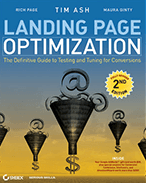The Truth About Conversion Rates: What You Really Need To Analyze
Last updated | SEO used to be the big buzzword online. Now conversion rates have become the big buzzword lately – unfortunately though too much emphasis is now being placed on them as the main way of determining website performance and success…
SEO used to be the big buzzword online. Now conversion rates have become the big buzzword lately – unfortunately though too much emphasis is now being placed on them as the main way of determining website performance and success…
But why? Believe it or not, a conversion rate metric in isolation is actually often problematic and too subjective.
Here the main reasons why you should NOT rely solely on just one conversion rate to determine how your website is performing:
– Too often live in a vacuum with no context. A great shopping cart conversion rate means little if you have a really high homepage bounce rate, losing you many potential clients.
– No two websites are exactly the same, therefore its misleading to benchmark against other website conversion rates in your industry. Your conversion rate is unique to your website.
– Depending on how you calculate them, conversion rates can easily be manipulated. For example using unique visitors instead of visits will result in a higher conversion rate.
– Conversion rates can be manipulated easily by altering traffic flows. Eliminating poorly converting traffic is often just a band-aid – you should really optimize all your traffic sources.
So if conversion rates on their own can be this problematic, what else indicates a well optimized and well converting website? Luckily there are many other indicators that are just as important to help you understand your website’s performance.
What you should really be looking for to indicate a well optimized website:
To help website owners and marketers understand these other success indicators, I have put together a checklist of what you really should be analyzing when trying to understand how well your website performs. These success indicators vary by website type, so I have broken them down by the main types. You should aim to be achieving all of these for your website type, not just one or two. Here is the list:
E-commerce websites:
- High percentage of repeat visits (above 50%)
- Low bounce rate of your homepage (below 40%)
- Low shopping cart abandonment rate (below 20%)
- High average order value (depending on average prices)
- Multiple products per order (at least 2.0 per order)
- Low average number of days until purchase (lower than 7 days)
- High total site order conversion rate (total site visits by/of orders)
- High usage of refer-a-friend & social tools (e.g. Facebook Like or sharing)
Media/publishing websites:
- High pageviews per visit (at least 6 PPV)
- High percentage of repeat visits (above 50%)
- High user initiated video views per visit (if applicable, at least 2)
- High registration form completion rates (higher than 30%)
- High ad revenue per page (depending on CPM & number of ads)
- High ad revenue per visit (depending on CPM & number of ads)
- High completion rate of newsletter sign up form (at least 50%)
- High usage of refer-a-friend & social tools (e.g. Facebook Like or sharing)
Lead generation websites:
- High sign-up form completion rate (higher than 50%)
- A high total site sign-up conversion rate (total site visits by/of orders)
- Low bounce rate of homepage (below 40%)
- Low exit rate of sign-up page (or first page of signup flow, below 40%)
- High whitepaper/request info form completion rate (higher than 50%)
Blogs:
- High average time spent on site (greater than 5 minutes)
- High average number of comments per page (more than 10)
- High number of RSS feed/email subscribers per unique visitor
- High pageviews per visit (at least 6 PPV)
- High percentage of repeat visits (above 50%)
- High usage of refer-a-friend & social tools (e.g. Facebook Like or sharing)
- High ad revenue per visit (if revenue is part of business model)
Community/social networking websites:
- High number of registered users (at least 1,000)
- Low bounce rate of your homepage (lower than 30%)
- High pageviews per visit (at least 6 PPV)
- High number of contributions per user (at least 2.0)
- High registration form completion rates (higher than 30%)
- High usage of refer-a-friend & social tools (e.g. Facebook Like or sharing)
So go ahead and check out these success indicators for your own website – you might be surprised at what you find. You now have no reason to continue to focus on conversion rates in isolation as the only way of determing how well optimized your website is and how well it performs overall. Your thoughts?



